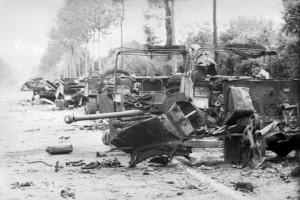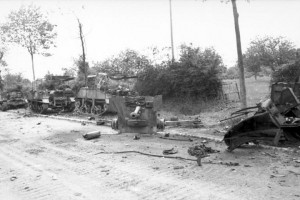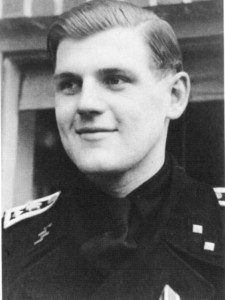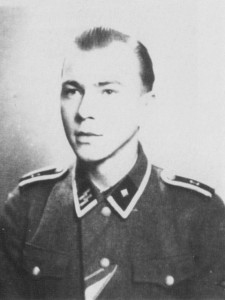Following his return from Villers-Bocage later in the day, Michael Wittmann would play down the action – describing it essentially as a simple drive along the column that had carried little serious risk. In reality, it was far from this simple an exercise, though by the same token it was nowhere near as expansive as the later German propaganda reports would later project. Seeing the seemingly never-ending British column straight ahead, Wittmann directed his Tiger head-on towards the RN 175 and the stationary vehicles of “A” Squadron 4CLY and A Coy 1st Rifle Brigade, risking a heavy barrage of return fire.
Had it been anyone other than Wittmann, and more crucially had he been commanding any vehicle other than the powerful Tiger I, the attack would have been seen as bordering on the suicidal. But Wittmann was both faster and more wily than the enemy, who could possibly have been lulled into a false sense of security given the ease of their journey into the town where they had met little resistance. The element of surprise was crucial.
Wittmann slowly approached the highway, accompanied by the two other running Tigers 221 and 223 belonging to SS-Untersturmführer Hantusch and SS-Oberscharführer Brandt, with SS-Unterscharführer Sowa in the half-fit 234 sitting back to provide the rearguard. Wittmann zeroed in on the vehicles to the rear of what was the advanced enemy column, while Hantusch and Brandt were to proceed east along the RN 175 to Hill 213.
Parked up against the side of the road, the lead vehicle of the British column had limited visibility, and it would be far too late when Wittmann’s advancing Tiger was spotted by Sergeant O’Connor of the 1st Rifle Brigade. O’Connor immediately raised the alarm, but by then the Panzer was already well within close firing range. As the two other Tigers from Wittmann’s company made their way up the RN 175 towards Hill 213, his crew prepared to engage.
As Wittmann’s Tiger charged relentlessly towards their positions on the RN 175, the “A” Squadron crews – who had at the time been quietly enjoying a cup of warm tea and a cigarette at the side of the road – were caught cold as Wittmann set about doing his own “brewing up”. The British crews had little or no time to return to their vehicles, let alone manoeuvre them into any sort of defensive position where they could have taken on the fearsome Tiger.
The first enemy vehicle Wittmann encountered was a stationary Cromwell at the rear of the column, which would have no chance against the Tiger’s powerful 88mm cannon at such close range. After taking out the Cromwell Wittmann then knocked out the next tank, a Sherman Firefly nicknamed “Blondie” – sending debris into the road which prevented any quick retreat by the remaining vehicles. With the exit to the north-east now blocked by the burning wreckage of the Firefly, Wittmann was then able to switch back onto the road leading back into the town, with the entire British column at his mercy.
Scattering and running for the nearest protection, the British crewmen hastily abandoned their stricken vehicles, some of which would still have their engines running. The Tiger’s loader, SS-Sturmmann Günther Boldt, had to work like a man possessed to keep with this tremendous rate. Gunner Bobby Woll then grabbed his MG34, peppering the scout car which had been standing next to the lead half-track with a hail of bullets.
While the bow machine gunner’s relentless MG34 fire prevented any of the British crewmen from emerging from their hiding places, Wittmann turned his attention to the array of lightly-protected vehicles conveniently lined up along the side of the road. Realising that he didn’t need to use the Tiger’s powerful 88mm KwK cannon, the dozen vehicles – eight M5A1 half-tracks and four carriers – were easily taken out with heavy fire from the pair of MG34s operated by Woll and bow gunner SS-Sturmmann Jonas. In all, by now a staggering fourteen vehicles and two 6-pounder anti-tank guns had been knocked out of commission in the space of a couple of minutes.
 |
 |
Having reduced the column of vehicles stationed on the RN 175 to a blazing inferno, Wittmann’s Tiger now headed down Rue Georges Clémenceau towards the eastern side of the town of Villers-Bocage itself, engaging the three M3 Stuart “Honey” light tanks belonging to 4CLY’s reconnaissance troop along the way at the junction with the road to Tilly-sur-Seulles – The “Tilly Junction”.
The lightly-armed 15-ton M3 Stuart was no match for the Tiger, but squad leader Lieutenant Rex Ingram still attempted to steer his vehicle “Calamity Jane II” into the road to at least try to stem the monster’s advance. Knowing that his 37mm M6 gun had no chance of penetrating the Tiger’s thick armour even at this close range, Ingram attempted to manoeuvre his small tank into the middle of the road to block Wittmann’s path. Ingram’s bravery was futile, and the last thing he and his crew would hear was the resounding crack of the Tiger’s 88mm cannon.
Lieutenant Ingram would have known that his attempt to take Wittmann’s Tiger head on was futile, but it was a decision that did buy valuable time and stave of the sense of panic. Temporarily halted by the blazing wreck of the Stuart, the German tank had to force the burning shell of Ingram’s off the road to clear a path. Having done so, the Tiger then turned its guns on the remaining two Stuarts, turning both in to blazing infernos.
The Tiger then slammed another 88mm shell into the scout car belonging to the RHQ Intelligence Officer, with the deadly shrapnel showering the panicking infantry. Wittmann himself then grabbed the MG34 mounted on his cupola, and joined his gunner in destroying the remaining half-track, that belonging to the medical officer Captain H. I. C. MacLean. The disabled vehicle was blown into the middle of the road, blocking the throughway and creating yet another obstruction for any vehicles that might have tried to escape the ensuing carnage.
With this latest set of obstacles out of his way, Wittmann was set to continue his advance. With the burning Stuarts and half-track behind it, the Tiger rolled towards the town.


